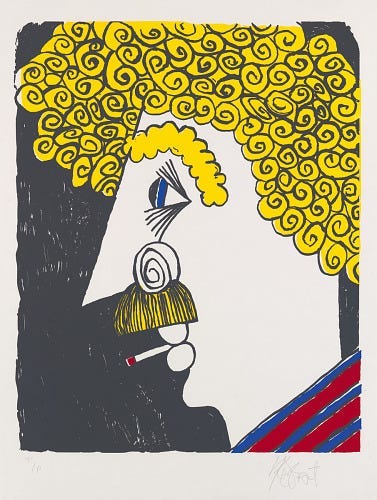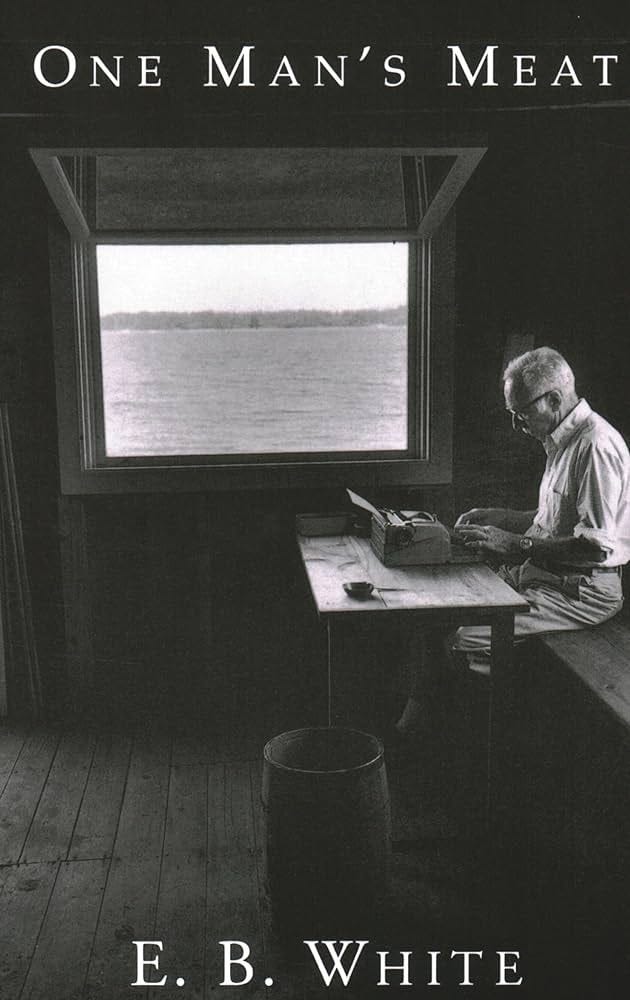Welcome to A Short Distance Ahead
I’m David Williams, a writer based in Philadelphia. And this newsletter is:
A Short Distance Ahead is a reference to the last sentence of Alan Turing’s famous paper, “Computing Machinery and Intelligence,” published seventy-four years ago in the journal, Mind (October 1950). The paper introduced the concept of what became known as the Turing Test, a method to evaluate a machine’s ability to exhibit intelligent behavior indistinguishable from that of a human.
Turing’s paper is widely considered the seminal, founding work in the field of artificial intelligence. Turing ends the paper with the following words:
“We can only see a short distance ahead, but we can see plenty there that needs to be done.”
This newsletter is not an attempt to keep up with the latest developments in AI. Rather, it is an attempt to look back, and hopefully provide moments of reflection, curiosity, and perhaps, understanding.
Here’s How It Will Go
Each week you will receive a short essay between 1,200-2,000 words.
Each essay will capture a snapshot of one year in history, with an emphasis on the evolution of AI, but also by weaving together the major milestones touching: politics, culture, science, philosophy, economics, and the environment.
Each essay will be co-researched and written with generative AI platforms —primarily Claude, an AI chatbot developed by Anthropic, and also with a custom GPT I created using OpenAI’s model.
We will experiment with formats, but the essay will be arranged in a style meant to highlight the interconnectedness and often absurd nature of human affairs.
The first essay, The Year Was 1950, was published on June 2nd, 2024.1
The newsletter will run for seventy-five weeks.
It will end the week of November 6th, 2025, with an essay titled, The Year Is 2025, marking the 75th anniversary of Turing’s paper.
What’s The Value Proposition?
Bridge the past and future of AI by examining the unexplored in-between.
Our world has come to be shaped, in large part, by the language of binaries — ones and zeros, facts, data points.
This computational framework, which forms the foundation of AI, often focuses on the precise algorithms and logical patterns created by these binary elements.
I believe that the most important aspect of this framework lies in the gaps between the 1s and 0s—the spaces we have become conditioned to overlook.
These gaps represent the nuances, context, deeper meaning, and narrative seeds that often elude simple binary representations.
At a time when we are flooded with information, much of it leaving us confused and disoriented (especially when it comes to AI), this newsletter aims to remind us that the unexplored in-between matters. Sometimes, context and meaning comes from the places we aren’t paying attention to, like the spaces in between the bits of information, and the stories beneath the deluge of data points.
The “unexplored in-between” is wide-ranging, for example: the overlooked connections between seemingly unrelated historical events and AI development, the broader cultural context that shaped AI’s development, evolving ethical and philosophical debates that arose as AI developed, how ideas from other fields shaped AI research, the gaps in public perception of understanding AI and its actual capabilities at different points in history, and unintended consequences of AI development that led to unexpected outcomes in other areas of society and technology.
These "in-between" areas are the rich, often overlooked spaces that this newsletter will explore, providing a more nuanced and comprehensive view of AI's history and potential future.
Introducing my Co-Writers
Barry-O
I created Barry-O with the description to be a creative, humorous, intelligent writing and research partner to assist in drafting weekly essays. I fed him a PDF file of Turing’s paper. I pointed him towards writers whose work inspired this project. Most specifically:
Europeana: A Brief History of the Twentieth Century, by Czech writer, Patrik Ourednik (the foundational inspiration for this newsletter)
The essays of Eliot Weinberger
And sci-fi writer Terry Bisson’s, This Month In History column, which ran for two decades in Locus magazine.
And, finally, I gave Barry-O a profile pic, pulled from one of Kurt Vonnegut’s self-portraits.
Barry-O’s primary focus will be research, providing me with important dates and milestones. I may also ask Barry-O to help me brainstorm, and edit and revise each week’s essay.
Claude
As the newsletter has developed, I’ve found Barry-O to be most helpful with research, but now mostly collaborate with Claude.
From time to time, I will also elicit editing help from Pi, an AI assistant developed by Inflection, now a part of Microsoft, as well as, Perplexity, self-described as “an AI powered answer engine” for additional help with research.
In other words, my attempt to chart humanity’s pursuit of machine minds will be co-created with machines.
A Note About This Process
I've embarked on the process of co-writing with AI as an experiment. In full disclosure, I have deep concerns about using these tools for creative purposes. Especially as someone who believes "we need fiction like we need water" – that stories flowing from unique human perspectives are essential nourishment for our consciousness. Lewis Hyde argues in The Gift that creative work is fundamentally different from commodity exchange; it's a gift that carries the spirit of the giver, creating connections between humans that transcend transaction. When we substitute or dilute this gift with algorithmically-generated text, we may risk losing the very essence that makes storytelling a sacred transmission of human experience.
I believe there is something fundamental that happens in our brains when we attempt to ‘extract’ the very personal waves of creative expression that flow within our ‘hearts and minds’ onto a blank page, canvas, etc. I am troubled by the potential effects that replacing that fundamental act of creative expression, or even by altering it slightly, will have on our minds, emotions, and collective creative consciousness.
But, I’ve come to believe the best way to be prepared for contemplating, defending, and discussing these concerns requires active engagement with these technologies. This is a deeper, more nuanced topic I hope to explore in greater depth in the Paid Subscriber tiers of this newsletter. I will also be sharing more details on my process of writing with these technologies and tools. Stay tuned.
A Bit About Me
First and foremost, I’m a writer who likes to explore the blurred lines of fact and fiction (and worry greatly about those blurry lines.)
Once upon a time I studied creative writing at The New School and HB Studios in New York City.
I’ve primarily spent my career helping organizations find their voice through narrative-driven content. I am obsessive about language, media, and narrative design.
At the start of 2023, I immersed myself in the world of artificial intelligence. I completed a DeepLearning.ai specialization in machine learning to understand best practices for deploying and managing generative AI, as well as a Parsons School of Design specialization for exploring the evolution of creativity, while learning how to design and develop projects utilizing creative AI.
Currently, I work as a fractional Product Marketing consultant helping organizations bring narrative depth to their go-to-market process and content products specializing in newsletters and new forms of micro-media.I
I fundamentally believe “we need fiction like we need water.” I am in the process of completing my first collection of loosely-linked, short stories, which I had the good fortune to workshop with the extraordinary, Amy Hempel, at The New York State Writer’s Institute for two weeks in 2024.
Recently, I was a fellowship candidate invited to join the final cohort of the Write of Passage five-week online writing intensive, which opened access to a community of 2000+ writers spanning across 72 countries.
For more about me, you can go here.
And one last note . . .
One Man’s Meat
One Man’s Meat by E.B. White is one of my favorite book of essays.2
The title is pulled from a two-thousand year old proverb: one man’s meat is another man’s poison, in other words, what pleases one person may displease another.
I fully expect this to be the case for this newsletter.
The very fact I’m trying to do something different here, lends itself to the natural expectation that many of you will find the whole premise of this newsletter to not be your “cup of tea,” so to speak.
If this isn’t for you, I assure you, there will be no hard feelings.
Regardless, I am grateful for your time and attention, and my pledge to you is that I will never take those two things for granted.
While our world continues to spin, a short distance ahead, may these essays provide moments of reflection, curiosity, and perhaps, understanding.
Thanks for reading.
Note that the early essays were pretty experimental and the format has evolved considerably.
Over a decade ago I found my way to White’s writing shed (pictured above), by piecing together bits and pieces of essay descriptions and White’s own vague directions he was said to have given to welcome visitors. It sat on the property that inspired Charlotte’s Web, and was a magical spot. Upon discovering the property, I convinced my (now) wife to join me in trespassing down to the water's edge, seeking the thrill of peering through the window that once captivated White's gaze. The simple wooden structure stood as a humble testament to the extraordinary stories born within its walls.





